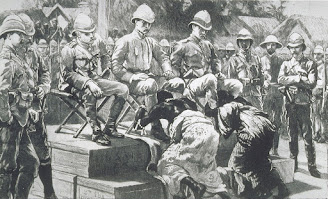SOCIOLOGY CLASS- XII
STRUCTURAL CHANGE
संरचनात्मक परिवर्तन
Structural Change (संरचनात्मक परिवर्तन) : Changes in social relationship.
Many instances we face in our daily life.
Parliamentary & legal system, police & education
system built very much on the British model.
School uniforms with neck ties
Bread-omlette as menu
English language is widely used in Indian society.
A major contributor to the growth of nationalism.
It’s knowledge has given Indians an edge in the global job market.
Linked to social prestige and status and also reduce the importance of caste position.
Colonialism (उपनिवेशवाद): The rule by one country over another.
Pre-colonial rulers were interested in continuous flow of tribute but did not interfere with the socio-economic system in place.
Changed not just land ownership laws but decided even what crops out to be grown and what not.
The way
of production and distribution of goods was altered
Tea
plantations were introduced. People were carted in ships outside the country. It
led to considerable movement of people within & outside India.
Forest
Acts changed the life of the rural people or pastoralists(चरवाहे).
Western
education was introduced to create Indians who could assist in administration.
Whereas British colonialism policy was towards the strengthening and expansion of British capitalism ( to ensure maximum profit).
Capitalism(पूंजीवाद): is an economic system in which the means of production are privately owned and is organized to accumulate profits within a market system.
Capitalism in the
west emerged out of a complex process of European exploration of the rest of
the world.
So, western colonialism connected to the growth of western
capitalism.
If capitalism became the dominant economic system, nation states
became the dominant political form.
Nation states are closely associated with the rise of nationalism(राष्ट्रवाद).
Nationalism assumes that people have an equal right &
sovereign(संप्रभुता).
Indian nationalist leaders opposed the foreign rule &
declared swaraj was their birth right and fought for both political &
economic freedom.
Two structural changes brought by colonialism.
1.Urbanization(नगरीकरण) 2. Industrialization (औधोगीकरण)
The Colonial Experience(औपनिवेशिक अनुभव)
Industrialization refers to emergence of machine production based on the use of power resource like steam, or electricity.
Large majority of population work in industries rather than agriculture.Britain, the first society to undergo industrialization.
But in India the impact of the very
same British industrialization led to deindustrialisation (औधोगिक क्षरण) in some sectors.
De-industrialization (औधोगिक क्षरण):It is a process of social and economic change caused by the reduction of industrial activity in a region. (decline of old urban centres)
Certain industries closed down as it could not compete with machine made goods from Europe.
Just as
manufacturing boomed in Britain, traditional exports of cotton and silk
manufactures from India declined in the face of Manchester competition.
The further decline of cities such as Surat and Masulipatnam while
Bombay and Madras grew.
British industrialisation destroyed many village industries.
Decline of some earlier/old urban centres, Coastal cities such
as Mumbai, Kolkata & Chennai had a key role in economic system.
Cities were the expression of global capitalism.
Bombay exported cotton,
Calcutta exported jute,
Madras exported coffee,sugar,indigo,cotton.
Kolkata was one of the first new colonial cities.
In 1690, An english merchant Job Charnock, selected
three villages named Kolikata, Gobindapur & Sutanati by the river Hugli in
order to set up a trading post.
In 1698, Fort William was established by the river for defensive
purposes.
The open area (called Maidan) around the fort for the military
enagagements, & formed the core of the city.
Tea plantations (चाय की बागवानी)
Harsh measures were taken against the labourers, for the benefit of the 'British planters.
The planters enjoyed luxurious lifestyles.They lived in huge bungalows maintained by the labourers.
Assam was ideal for tea plantation. But due to low population the workers were recruited from far off places.
The labourers worked in unfavorable conditions. & also harsh weather conditions caused diseases.
Industrialization in Independent India (स्वतंत्र भारत में औधिगीकरण)
For Indian nationalists central issue was economic exploitation.
Then the Swadeshi movement strengthened the loyalty to the national
economy.
Modern ideas made people realize that poverty was preventable.
Indian nationalists saw industrialization as the path towards
growth & social equity.
Development of heavy and machine making industries.
Expansion of public sector.
Development of a large cooperative sector.
A modern & prosperous India, as visualised by Jawaharlal
Nehru.
Built steel plants, power stations, dams.
In 1938, A National Planning committee was set up with Jawahar Lal Nehru as the Chairman and K T shah as the General Editor.
The major areas of focus were:
Agriculture, Industries, Human factor, Exchange and finance, Public utilities, transport and communication, Education-general and technical, Women's role in a planned economy.
The Planning commission was set up in March 1950 by the resolution of the Government of India, which is defining the scoipe of the commission's work.
Urbanization in Independent India (स्वतंत्र भारत में नगरीकरण)
M.S.A.
Rao argued that the impact of urban influences increasingly on many Indian villages. He describes three
different situation….
(a) Villages
in which sizable population are employed in far off cities or in overseas
towns. Members of their families are left behind.
(b)
Villages which are situated near an
industrial town like Bhilai, Bokaro.
(c) Villages surrounding
ever expanding metropolitan cities like Delhi, Mumbai.





